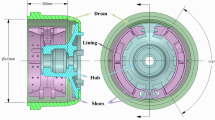Abstract
Despite significant efforts made in the last two decades for the analysis and prediction of brake squeal propensity, brake squeal remains a major source of customer dissatisfaction and warranty-related costs. Brake squeal is a fugitive nonlinear self-excitation phenomenon induced by friction. Traditional linear complex eigenvalue analysis (CEA) combined with noise dynamometer tests has achieved some success in the analysis of brake squeal and in designing countermeasures in suppressing brake squeal. However, prediction of brake squeal propensity without experimental tests is generally unreliable because of three main challenges. Firstly, most conventional analysis methods used are linear but brake squeal could be caused by nonlinearities. Secondly, while nonlinear time-domain simulations have achieved some success, they require substantial high-performance computing resources and are too time-consuming for practical applications. Thirdly, even if the second challenge can be overcome, there are many determining and interacting factors that are not known exactly, such as material properties of pad and disc, operating conditions (brake pad pressure, temperature, speed), contact conditions between pad and disc, nonlinear boundary conditions and modelling of friction. In this chapter, examples are given to illustrate the success and limitations of the CEA. To address difficulties in predicting brake squeal posed by nonlinearity, uncertain contact conditions and friction modelling, examples will be given to illustrate how a stochastic approach using the traditional linear eigenvalue analysis could be applied to improve the prediction of brake squeal by identifying unstable vibration modes that are not too sensitive to these uncertainties.
Access this chapter
Tax calculation will be finalised at checkout
Purchases are for personal use only
Similar content being viewed by others
References
Kinkaid, N.M., O'Reilly, O.M., Papadopoulos, P.: Automotive disc brake squeal. J. Sound Vib. 267, 105–166 (2003)
AbuBakar, A.R., Ouyang, H.J.: A prediction methodology of disk brake squeal using complex eigenvalue analysis. Int. J. Veh. Des. 46, 416–435 (2008)
Papinniemi, A., Lai, J.C.S.: A study on in-plane vibration modes in disc brake squeal noise. Proceedings of Inter-Noise 2005, Rio de Janeiro, 10 pp (2005)
Oberst, S., Lai, J.C.S.: Chaos in brake squeal noise. J. Sound Vib. 330, 955–975 (2011)
Oberst, S., Lai, J.C.S.: Nonlinear transient and chaotic interactions in disc brake squeal. J. Sound Vib. 2015, 272–289 (2015)
Zhang, Z., Oberst, S., Lai, J.C.S.: Instability analysis of friction oscillators with uncertainty in the friction law distribution. IMechE J. Mech. Eng. Sci. 230, 948–958 (2016)
Oberst, S., Lai, J.C.S.: Uncertainty modelling for detecting friction-induced pad-mode instabilities in disc brake squeal. Proceedings of ICA 2010, Sydney, 12 pp (2010)
Zhang, Z., Oberst, S., Lai, J.C.S.: On the potential of uncertainty analysis for prediction of brake squeal propensity. J. Sound Vib. 377, 123–132 (2016)
Stender, M., Tiedemann, M., Hoffmann, N., Oberst, S.: Impact of an irregular friction formulation on dynamics of a minimal model for brake squeal. Mech. Syst. Signal Process. 107, 439–451 (2018)
Stender, M., Oberst, S., Tiedemann, M., Hoffmann, N.: Complex machine dynamics: systematical recurrence analysis of disk brake vibration data. Nonlinear Dyn. (2019). https://doi.org/10.1007/s11071-019-05143-x
Sinou, J.J.: Transient non-linear dynamic analysis of automotive disc brake squeal - on the need to consider both stability and non-linear analysis. Mech. Res. Commun. 37, 96–105 (2010)
Butlin, T., Woodhouse, J.: Friction-induced vibration: quantifying sensitivity and uncertainty. J. Sound Vib. 329, 509–526 (2010)
Culla, A., Massi, F.: Uncertainty model for contact instability prediction. J. Acoust. Soc. Am. 126, 1111–1119 (2009)
Renault, A., Massa, F., Lallemand, B., Tison, T.: Experimental investigations for uncertainty quantification in brake squeal analysis. J. Sound Vib. 367, 37–55 (2016)
Tison, T., Heusaff, A., Massa, F., Tupin, I., Nunes, R.: Improvement in the predictivity of squeal simulations: uncertainty and robustness. J. Sound Vib. 333, 3394–3412 (2014)
Author information
Authors and Affiliations
Corresponding author
Editor information
Editors and Affiliations
Rights and permissions
Copyright information
© 2021 Springer Nature Switzerland AG
About this paper
Cite this paper
Zhang, Z., Oberst, S., Lai, J.C.S. (2021). Towards Overcoming the Challenges of the Prediction of Brake Squeal Propensity. In: Oberst, S., Halkon, B., Ji, J., Brown, T. (eds) Vibration Engineering for a Sustainable Future. Springer, Cham. https://doi.org/10.1007/978-3-030-47618-2_6
Download citation
DOI: https://doi.org/10.1007/978-3-030-47618-2_6
Published:
Publisher Name: Springer, Cham
Print ISBN: 978-3-030-47617-5
Online ISBN: 978-3-030-47618-2
eBook Packages: EngineeringEngineering (R0)




